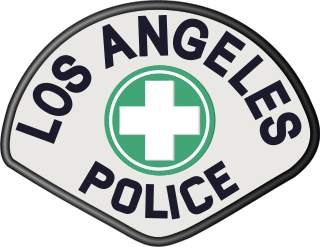
The Los Angeles Police Department (LAPD), officially known as the City of Los Angeles Police Department, is the primary law enforcement agency of Los Angeles, California, United States. With 8,832 officers and 3,000 civilian staff, it is the third-largest municipal police department in the United States, after the New York City Police Department and the Chicago Police Department.

Bernard C. Parks is an American politician who served as a member of the Los Angeles City Council, representing the 8th district in South Los Angeles from 2003 to 2015. A member of the Democratic Party, Parks served as Chief of the Los Angeles Police Department from August 1997 to May 2002.

The Rampart scandal was a police corruption scandal which unfolded in Los Angeles, California during the late 1990s and early 2000s. The scandal concerned widespread criminal activity within the Community Resources Against Street Hoodlums (CRASH) anti-gang unit of the Los Angeles Police Department's Rampart Division. More than 70 police officers were initially implicated in various forms of misconduct, including unprovoked shootings and beatings, planting of false evidence, stealing and dealing narcotics, bank robbery, perjury and cover-ups thereof.

James Edgar Davis was an American police officer who served as the chief of the Los Angeles Police Department (LAPD) from 1926 to 1929, and from 1933 to 1939. During his first term as LAPD chief, Davis emphasized firearms training. Under Davis, the LAPD developed its lasting reputation as an organization that relied on brute force to enforce public order. It also became publicly entangled in corruption. Members of the LAPD were revealed to have undertaken a campaign of brutal harassment, including the bombings of political reformers who had incurred the wrath of the department and the civic administration.
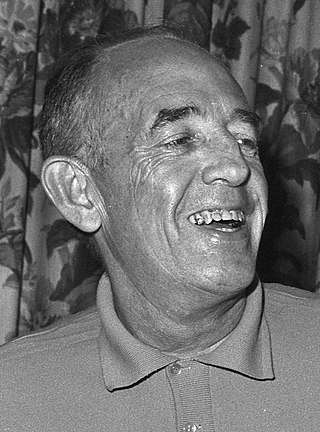
William Henry Parker III was an American law enforcement officer who was Chief of the Los Angeles Police Department (LAPD) from 1950 to 1966. To date, he is the longest-serving LAPD police chief. Parker has been called "Los Angeles' greatest and most controversial chief of police". The former headquarters of the LAPD, the Parker Center, was named after him. During his tenure, the LAPD was known for police brutality and racism; Parker himself was known for his "unambiguous racism".
Willie L. Williams was an American police officer who served as the chief of the Los Angeles Police Department (LAPD) from 1992 to 1997, taking over after chief Daryl Gates' resignation following the 1992 Los Angeles riots. Williams was the first African-American Commissioner of the Philadelphia Police Department and the first African-American Chief of the LAPD. During his term as Chief of the LAPD, he tried to create a positive image of the department and close the rift created between the police and black neighborhoods by the violent arrest of Rodney King in 1991.

Clemence Brooks Horrall was Los Angeles Police Department chief of police from June 16, 1941, when he succeeded Arthur C. Hohmann to serve as the 41st chief of the L.A.P.D., to June 28, 1949, when he resigned under pressure during a grand jury investigation of police corruption. Clemence Brooks Horrall was born in Washington, Indiana and graduated from Washington State University. Horrall had become chief when Hohmann, under pressure from Los Angeles Mayor Fletcher Bowron, voluntarily took a demotion to deputy chief after he had become ensnared in a police corruption trial that had embarrassed the mayor.
Arthur Clarence Hohmann served as Los Angeles Police Department Chief of Police from 1939 to 1941, when he voluntarily relinquished the position during a police corruption scandal. Hohmann was the 40th Chief of the L.A.P.D., succeeding acting Chief David A. Davidson in July 1939. He previously had been a lieutenant.
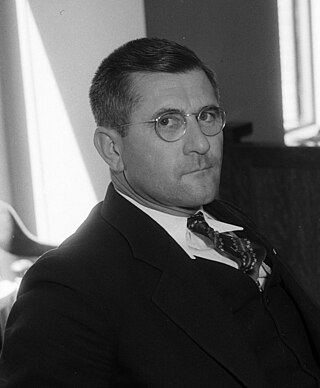
Roy Edmund Steckel was the Los Angeles Police Department Chief of Police from December 30, 1929, to August 9, 1933. He succeeded and was succeeded as chief by James E. "Two-Guns" Davis. During Steckel's reign as Chief of Police, Los Angeles hosted the 1932 Summer Olympic Games. The L.A.P.D. employed 800 duly sworn police officers. According to the L.A.P.D.'s official site, crime was very low during the Olympics, with there being only "two robberies, eight burglaries, 39 thefts, and 10 auto thefts".
Edward McCarthy was the sixth Chief of Police of Los Angeles Police Department and had one of the shortest commands of any chief. He was forced out of office on May 12, 1885, after serving since January 2 of the same year.

The Los Angeles Police Department (LAPD) was formed in 1869, and has since become the third-largest law enforcement agency in the United States. They have been involved in various events in history, such as the Black Dahlia murder, the Watts riots, the 1992 Los Angeles riots, the North Hollywood shootout, the murder trial of O. J. Simpson, and the Rampart scandal.
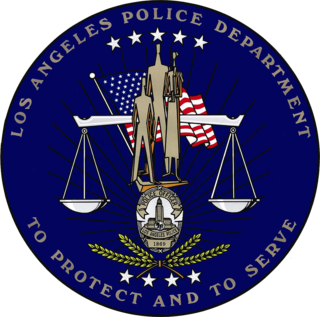
The Chief of the Los Angeles Police Department is the head and senior-most officer to serve in the Los Angeles Police Department (LAPD). The incumbent manages the day-to-day operations of the LAPD and is usually held a four star officer.

Metropolitan Division, commonly referred to as Metro Division or just Metro, is an elite division of the Los Angeles Police Department (LAPD) under its Special Operations Group. Metropolitan Division is responsible for managing the LAPD's specialized crime suppression, K-9, mounted, and SWAT units, named "platoons".

George Gascón is an American attorney and former police officer who is the exiting district attorney of Los Angeles County. A member of the Democratic Party and a former member of the Republican Party, Gascón served as the district attorney of San Francisco from 2011 to 2019. Prior to his work as a prosecutor, he was an assistant chief of police for the LAPD, and Chief of Police in Mesa, Arizona and San Francisco.

Charles Lloyd Beck is a retired American police officer, formerly serving as the Chief of the Los Angeles Police Department (LAPD) and subsequently as the Superintendent of the Chicago Police Department. A veteran of the department with over four decades as an officer, he is known for commanding and rehabilitating the Rampart Division after the Rampart scandal; and for technology enhancements during his time as Chief of Detectives. He agreed to be interim Superintendent of Police in Chicago in late 2019 while the city searches nationwide for a replacement for retiring Eddie Johnson. Beck took the helm of the Chicago Police Department on December 2, 2019, after Johnson was fired. On April 15, 2020, Beck stepped down and was replaced by former Dallas Police Department Chief David Brown, who had been nominated by Lightfoot to serve as permanent Superintendent. After his retirement he rejoined the Reserve Corps as a Reserve Police Officer and is assigned to the Office Of The Chief Of Police.

David A. Davidson was the 39th Chief of Police of the Los Angeles Police Department, succeeding James E. Davis. Promoted from the rank of inspector, Davidson served as acting Chief of Police from November 19, 1938 to June 23, 1939, and was succeeded by Arthur C. Hohmann, a police lieutenant who was appointed chief by the Police Commission. During his term of office, Davidson authorized policewomen to be armed. Under his directive, in 1939, L.A.P.D. policewomen were ordered to go through fire arms training, after which they were issued .38 caliber revolvers.

R. Lee Heath served as Chief of Police of the Los Angeles Police Department from August 1, 1924 to March 31, 1926. Heath had joined the L.A.P.D. in 1904 and was reputed to be the most adroit politician in the department, eventually rising to the level of top cop. He was a police captain when he was appointed chief, replacing Chief August Vollmer, the former Police Chief of Berkeley, California who had served as interim chief for exactly one year.

Louis D. Oaks was an American police officer. He served as the Chief of Police of the Los Angeles Police Department from April 22, 1922 to August 1, 1923. He succeeded James W. Everington and was succeeded by ex-Berkeley, California Police Chief August Vollmer, a prominent criminologist.

Ezell Ford, a 25-year-old African-American man, died from multiple gunshot wounds after being shot by Los Angeles Police Department (LAPD) officers in Florence, Los Angeles, California on August 11, 2014. In the weeks and months that followed, Ford's shooting triggered multiple demonstrations and a lawsuit by Ford's family claiming $75 million in damages.
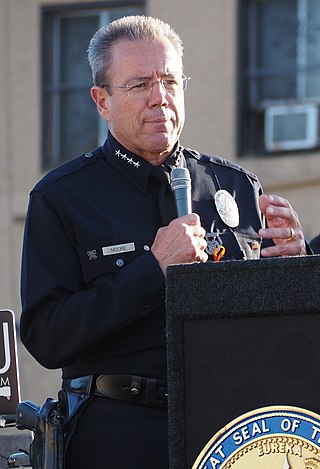
Michel Rey Moore is a retired American law enforcement officer who served as the chief of the Los Angeles Police Department (LAPD) from 2018 until 2024.


















